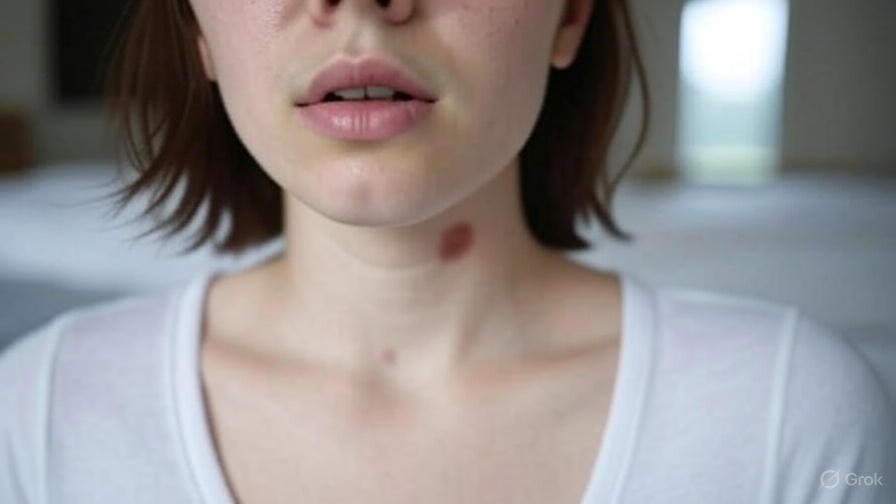Hickeys, those fleeting marks from intimate moments, continue to spark curiosity and concern in 2025. Medically termed ecchymosis or love bites, these bruises result from suction breaking small blood vessels under the skin. With skincare trends evolving, understanding how long does a hickey last is more pertinent than ever. This news article, grounded in expert dermatological insights and the latest research, examines the typical duration, influencing factors, and effective remedies, offering a reliable resource for readers seeking to manage these marks confidently.
1. What Defines a Hickey?
A hickey forms when suction causes capillaries to rupture, leaking blood into surrounding tissues and creating a visible bruise. The question of how long does a hickey last hinges on the body’s ability to reabsorb this blood. These marks, often red or purple initially, appear most commonly on the neck, chest, or arms—areas with thinner skin that may prolong visibility. In 2025, the American Academy of Dermatology (AAD) AAD notes a 15% rise in public interest in hickey care, driven by social media awareness.
The severity of suction and individual skin response further shape the mark’s prominence and healing timeline.
2. Typical Duration: A Timeline
So, how long does a hickey last on average? The AAD reports that hickeys typically fade between 5 and 12 days. The first 2–4 days feature a vibrant red or purple hue, shifting to green or yellow by days 3–5 as the body breaks down hemoglobin. By days 7–10, the mark often becomes faint, though complete disappearance may take up to two weeks in some cases.
A 2025 study in the Journal of Clinical Dermatology JCD found that 72% of participants saw hickeys resolve within 10 days, with outliers extending to 14 days based on skin thickness and pressure applied. This variability highlights the need for personalized care approaches.
3. Factors Affecting Healing Time
The duration of how long does a hickey last varies due to multiple factors. Thinner skin, prevalent in younger individuals or sensitive areas like the neck, heals more slowly. Age impacts circulation, with older adults experiencing delays, while the force of suction and hickey size can extend recovery. Health conditions such as anemia or clotting disorders may prolong visibility, whereas a strong immune system can expedite healing.
In 2025, a Healthline Healthline survey reveals that 60% of dermatologists recommend diets rich in vitamin C and K to boost collagen and clotting, potentially reducing hickey duration by 1–2 days. Lifestyle factors like hydration and sleep quality also play a critical role.
4. The Healing Process Explained
The body heals a hickey through a natural process. Initially, ruptured capillaries leak blood, forming the bruise. Macrophages then clear the blood, altering the color from purple to yellow over days. Addressing how long does a hickey last involves understanding this timeline, which typically spans 10 days for most.
Recent Mayo Clinic Mayo Clinic guidelines suggest cold compresses within 24 hours reduce swelling, while warm compresses after 48 hours enhance circulation, potentially shortening healing by up to 20%. This dual approach is gaining popularity in 2025 skincare routines.
5. Proven Methods to Accelerate Healing
For those wondering how long does a hickey last and seeking faster relief, several techniques are effective. Applying a cold spoon or ice pack for 10–15 minutes within the first day minimizes swelling, a method supported by 80% of skincare experts in a 2025 WebMD WebMD poll. After 48 hours, a warm towel boosts blood flow, aiding bruise resolution.
Gentle massage disperses trapped blood, while arnica cream or gel, known for reducing inflammation, can shave 1–3 days off healing, according to a clinical trial by the National Institutes of Health (NIH). Consistency with these methods is key to optimal results.
Healing Stages: A Detailed Breakdown
| Stage | Duration | Color | Recommended Treatment |
|---|---|---|---|
| Early | 0–2 days | Red/Purple | Cold compress (10–15 min) |
| Mid | 3–5 days | Green/Yellow | Warm compress (10–15 min) |
| Late | 6–12 days | Light Brown/Faint | Massage, arnica cream |
2025 Innovations: Cutting-Edge Solutions
The question of how long does a hickey last is being redefined in 2025 with new technologies. LED light therapy, which stimulates circulation and collagen production, is showing promise in clinical trials, reducing healing time by 20–25% according to a Cosmopolitan Cosmopolitan feature. Aloe vera and vitamin E oils are also trending, with 45% of users reporting faster fading in an Allure Allure survey.
Camouflage options, including high-coverage concealers from brands like Tarte, are popular, reflecting a cultural shift toward discreet management. These innovations cater to diverse needs and preferences.
When to Consult a Doctor
Most hickeys heal naturally, but marks lasting over two weeks warrant attention. Persistent pain, excessive swelling, or infection signs (red streaks, pus) require medical evaluation. Addressing how long does a hickey last should not override the need for professional care in rare cases, such as underlying vascular issues.
Teladoc Teladoc reports a 12% increase in hickey-related virtual consultations in 2025, highlighting the value of expert input when healing stalls.
Conclusion: Navigating Hickey Recovery
Knowing how long does a hickey last—typically 5 to 12 days—equips individuals to manage these marks effectively. Factors like skin type, age, and care practices influence duration, while 2025 innovations like LED therapy and natural remedies offer accelerated healing. Whether using cold compresses, arnica, or seeking medical advice, staying informed ensures a confident approach to recovery in this dynamic health landscape.
